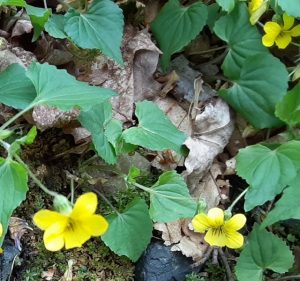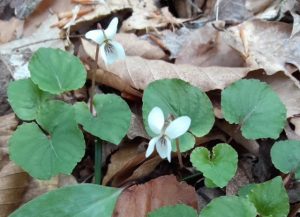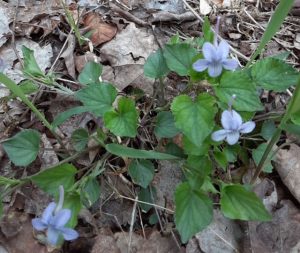By: Susan Sprout
What a bouquet of Violets I discovered on my Mothers’ Day rambles! They weren’t my common backyard and garden blues. They were white and yellow and purple! Members of the Violet Family, VIOLACEAE, there are more than seventy-seven species throughout North America. My PA plant resource lists forty living in this state.

Violets are grouped together based on whether they have their flowers and leaves on the same stalk (stemmed species) or on different stalks with leaves and flowers growing singly from their underground rhizomes (stemless species). All blooms have five petals, but size, shape, color, nectar guides, length of beards on side petals that bees have to squeeze through…all separate them further into species. And the leaves…shapes from heart to birdfoot to lance and halbert, with varying degrees of smooth and hairy.

Seed capsules and the seeds themselves have their own special colors and attitudes of growth, pointing upward when ripening and ejecting seeds several feet where they may be gathered by ants for their fats and used to feed their larvae.
Trying to identify violets is difficult because they also hybridize! Three species I am relatively sure of are all natives and like rich woods and openings along roadways. Sweet White Violet: white stemless flowers, bent-back top petals, smooth reddish stems. Long-spurred Violet: pale lavender stemmed flowers, leaf tip very pointed with a smattering of hairs, quite a long spur containing nectar. Downy Yellow Violet: yellow stemmed flower and leaves with hairy stems, long tapering point on leaves.

The great thing about violets is no matter which ones you find or where they are growing, you will know they all have high wildlife value – caterpillars, butterflies, moths, bees, small wasps, ants, chewing insects – they all love ’em. Yeah! I do, too!

